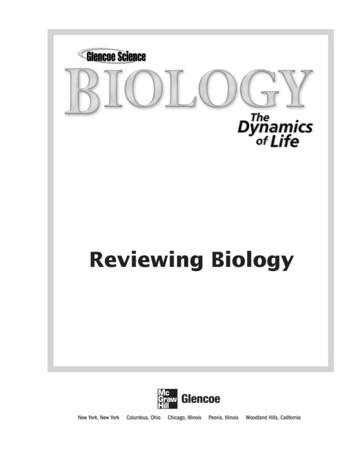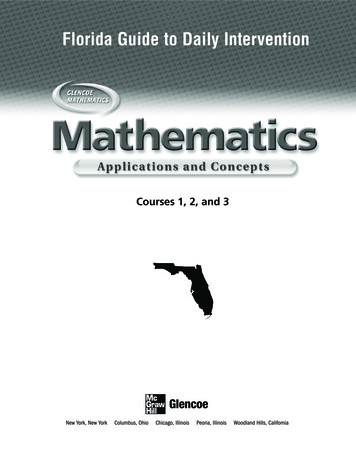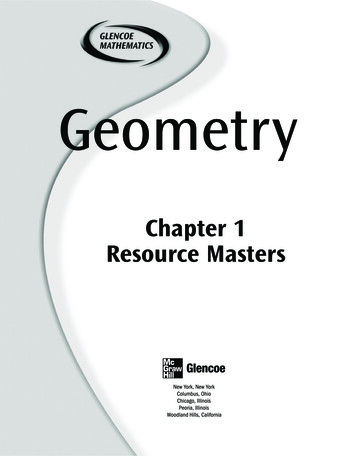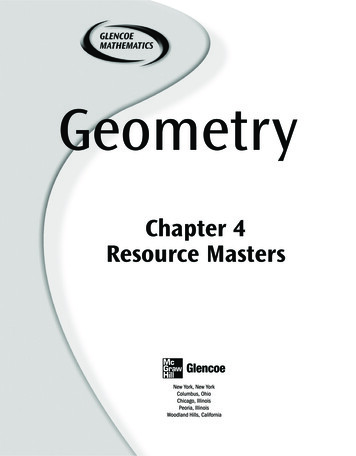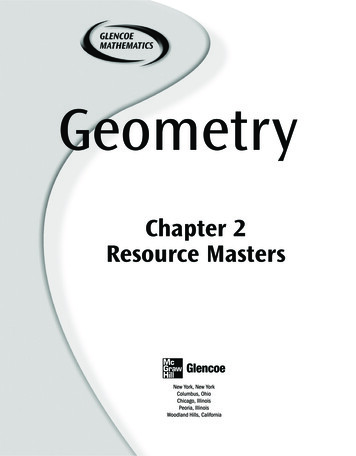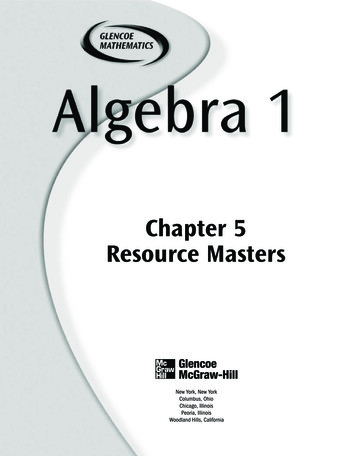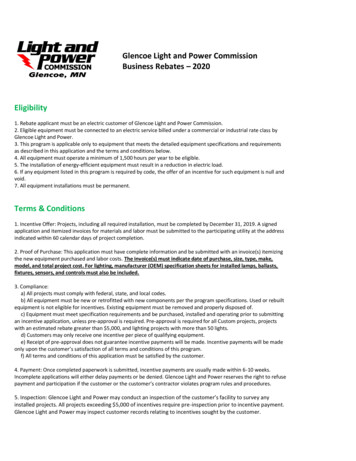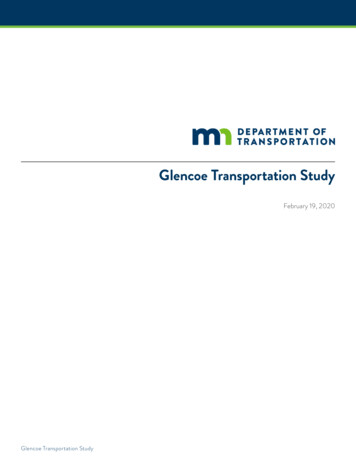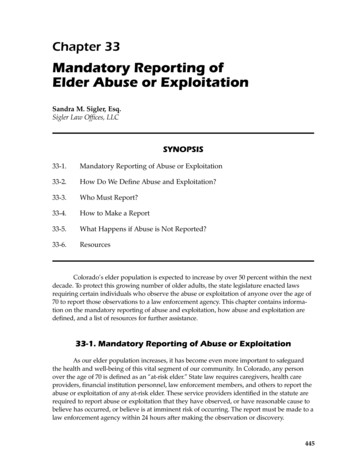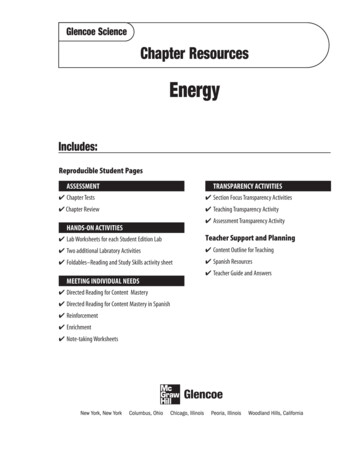
Transcription
Glencoe ScienceChapter ResourcesEnergyIncludes:Reproducible Student PagesASSESSMENTTRANSPARENCY ACTIVITIES Chapter Tests Section Focus Transparency Activities Chapter Review Teaching Transparency ActivityHANDS-ON ACTIVITIES Assessment Transparency Activity Lab Worksheets for each Student Edition LabTeacher Support and Planning Two additional Labratory Activities Content Outline for Teaching Foldables–Reading and Study Skills activity sheet Spanish Resources Teacher Guide and AnswersMEETING INDIVIDUAL NEEDS Directed Reading for Content Mastery Directed Reading for Content Mastery in Spanish Reinforcement Enrichment Note-taking Worksheets
Glencoe SciencePhoto CreditsCover: LM Cumming/CORBISSection Focus Transparency 1: (bl) Amoz Eckerson, (t) Francis E. Caldwell/Visuals Unlimited,(br) Robert Essel/The Stock MarketSection Focus Transparency 2: Dwight KuhnCopyright by The McGraw-Hill Companies, Inc. All rights reserved.Permission is granted to reproduce the material contained herein on the conditionthat such material be reproduced only for classroom use; be provided to students,teachers, and families without charge; and be used solely in conjunction with theGlencoe Science program. Any other reproduction, for use or sale, is prohibitedwithout prior written permission of the publisher.Send all inquiries to:Glencoe/McGraw-Hill8787 Orion PlaceColumbus, OH 43240-4027ISBN 0-07-872526-7Printed in the United States of America.1 2 3 4 5 6 7 8 9 10 024 08 07 06 05
Table of ContentsTo the TeacherReproducible Student Pages ivHands-On ActivitiesMiniLAB: Interpreting Data from a Slingshot . . . . . . . . . . . . . . . . . . . . . . . . . . . . . . . . . . . . . . . . . . . 3MiniLAB: Try at Home Transforming Energy in a Paper Clip . . . . . . . . . . . . . . . . . . . . . . . . . . . . . . . 4Lab: Bouncing Balls . . . . . . . . . . . . . . . . . . . . . . . . . . . . . . . . . . . . . . . . . . . . . . . . . . . . . . . . . . . . . . . 5Lab: Design Your Own Swinging Energy . . . . . . . . . . . . . . . . . . . . . . . . . . . . . . . . . . . . . . . . . . . . . . . 7Laboratory Activity 1: The Energy of a Pendulum . . . . . . . . . . . . . . . . . . . . . . . . . . . . . . . . . . . . . . . . 9Laboratory Activity 2: Causing Friction . . . . . . . . . . . . . . . . . . . . . . . . . . . . . . . . . . . . . . . . . . . . . . . 13Foldables: Reading and Study Skills . . . . . . . . . . . . . . . . . . . . . . . . . . . . . . . . . . . . . . . . . . . . . . . . . 17 Meeting Individual NeedsExtension and InterventionDirected Reading for Content Mastery . . . . . . . . . . . . . . . . . . . . . . . . . . . . . . . . . . . . . . . . . . . . . . . 19Directed Reading for Content Mastery in Spanish . . . . . . . . . . . . . . . . . . . . . . . . . . . . . . . . . . . . . . 23Reinforcement . . . . . . . . . . . . . . . . . . . . . . . . . . . . . . . . . . . . . . . . . . . . . . . . . . . . . . . . . . . . . . . . . . 27Enrichment . . . . . . . . . . . . . . . . . . . . . . . . . . . . . . . . . . . . . . . . . . . . . . . . . . . . . . . . . . . . . . . . . . . . 29Note-taking Worksheet . . . . . . . . . . . . . . . . . . . . . . . . . . . . . . . . . . . . . . . . . . . . . . . . . . . . . . . . . . . 31 AssessmentChapter Review . . . . . . . . . . . . . . . . . . . . . . . . . . . . . . . . . . . . . . . . . . . . . . . . . . . . . . . . . . . . . . . . . 35Chapter Test . . . . . . . . . . . . . . . . . . . . . . . . . . . . . . . . . . . . . . . . . . . . . . . . . . . . . . . . . . . . . . . . . . . . 37 Transparency ActivitiesSection Focus Transparency Activities. . . . . . . . . . . . . . . . . . . . . . . . . . . . . . . . . . . . . . . . . . . . . . . . 42Teaching Transparency Activity . . . . . . . . . . . . . . . . . . . . . . . . . . . . . . . . . . . . . . . . . . . . . . . . . . . . . 45Assessment Transparency Activity . . . . . . . . . . . . . . . . . . . . . . . . . . . . . . . . . . . . . . . . . . . . . . . . . . . 47Teacher Support and PlanningContent Outline for Teaching . . . . . . . . . . . . . . . . . . . . . . . . . . . . . . . . . . . . . . . . . . . . . . . . . . . . . . T2Spanish Resources . . . . . . . . . . . . . . . . . . . . . . . . . . . . . . . . . . . . . . . . . . . . . . . . . . . . . . . . . . . . . . T4Teacher Guide and Answers . . . . . . . . . . . . . . . . . . . . . . . . . . . . . . . . . . . . . . . . . . . . . . . . . . . . . . . T8Additional Assessment Resources available with Glencoe Science: ExamView Pro TestMakerAssessment TransparenciesPerformance Assessment in the Science ClassroomStandardized Test Practice BookletMindJogger VideoquizzesVocabulary PuzzleMaker at: gpescience.comInteractive ChalkboardThe Glencoe Science Web site at: gpescience.comAn interactive version of this textbook along with assessment resources are availableonline at: mhln.comiii
To the TeacherThis chapter-based booklet contains all of the resource materials to help you teachthis chapter more effectively. Within you will find:Reproducible pages for Student Assessment Hands-on Activities Meeting Individual Needs (Extension and Intervention) Transparency ActivitiesA teacher support and planning section including Content Outline of the chapter Spanish Resources Answers and teacher notes for the worksheetsHands-On ActivitiesLaboratory Activities: These activities do not require elaborate supplies or extensive pre-labpreparations. These student-oriented labs are designed to explore science through a stimulating yet simple and relaxed approach to each topic. Helpful comments, suggestions, andanswers to all questions are provided in the Teacher Guide and Answers section.Foldables: At the beginning of each chapter there is a Foldables: Reading & Study Skillsactivity written by renowned educator, Dinah Zike, that provides students with a tool thatthey can make themselves to organize some of the information in the chapter. Students maymake an organizational study fold, a cause and effect study fold, or a compare and contraststudy fold, to name a few. The accompanying Foldables worksheet found in this resourcebooklet provides an additional resource to help students demonstrate their grasp of theconcepts. The worksheet may contain titles, subtitles, text, or graphics students need tocomplete the study fold.Meeting Individual Needs (Extension and Intervention)Directed Reading for Content Mastery: These worksheets are designed to provide studentswith learning difficulties with an aid to learning and understanding the vocabulary andmajor concepts of each chapter. The Content Mastery worksheets contain a variety of formatsto engage students as they master the basics of the chapter. Answers are provided in theTeacher Guide and Answers section.ivCopyright Glencoe/McGraw-Hill, a division of The McGraw-Hill Companies, Inc.MiniLAB and Lab Worksheets: Each of these worksheets is an expanded version of each laband MiniLAB found in the Student Edition. The materials lists, procedures, and questionsare repeated so that students do not need their texts open during the lab. Write-on rules areincluded for any questions. Tables/charts/graphs are often included for students to recordtheir observations. Additional lab preparation information is provided in the Teacher Guideand Answers section.
Directed Reading for Content Mastery (in Spanish): A Spanish version of the DirectedReading for Content Mastery is provided for those Spanish-speaking students who arelearning English.Reinforcement: These worksheets provide an additional resource for reviewing the concepts of the chapter. There is one worksheet for each section, or lesson, of the chapter.The Reinforcement worksheets are designed to focus primarily on science content and lesson vocabulary, although knowledge of vocabulary supports understanding of the content.The worksheets are designed for the full range of students; however, they will be morechallenging for your lower-ability students. Answers are provided in the Teacher Guideand Answers section.Enrichment: These worksheets are directed toward above-average students and allow themto explore further the information and concepts introduced in the section. A variety offormats are used for these worksheets: readings to analyze; problems to solve; diagramsto examine and analyze; or simple activities or labs that students can complete in theclassroom or at home. Answers are provided in the Teacher Guide and Answers section.Note-taking Worksheet: The Note-taking Worksheet mirrors the content contained in theteacher version—Content Outline for Teaching. It can be used by students to take notes during class, as an additional review of the material in the chapter, or as study notes if studentshave been absent.Copyright Glencoe/McGraw-Hill, a division of The McGraw-Hill Companies, Inc.AssessmentChapter Review: These worksheets prepare students for the chapter test. TheChapter Review worksheets cover all major vocabulary, concepts, and objectivesof the chapter. The first part reviews vocabulary and the second part reviews concepts.Answers and objective correlations are provided in the Teacher Guide and Answers section.Chapter Test: The Chapter Test requires students to use process skills and understand content.Although all questions involve memory to some degree, you will find that your students willneed to discover relationships among facts and concepts in some questions and to use higherlevels of critical thinking to apply concepts in other questions. Each chapter test normallyconsists of four parts: Testing Concepts measures recall and recognition of vocabulary andfacts in the chapter; Understanding Concepts requires interpretation of information and morecomprehension than recognition and recall—students will interpret basic information anddemonstrate their ability to determine relationships among facts, generalizations, definitions,and skills; Applying Concepts calls for the highest level of comprehension and inference;Writing Skills requires students to define or describe concepts in multiple sentence answers.Answers and objective correlations are provided in the Teacher Guide and Answers section.Transparency ActivitiesSection Focus Transparencies: These transparencies are designed to generate interestand focus students’ attention on the topics presented in the sections and/or to assessprior knowledge. There is a transparency for each section, or lesson, in the Student Edition.The reproducible student masters are located in the Transparency Activities section. Theteacher material, located in the Teacher Guide and Answers section, includes TransparencyTeaching Tips, a Content Background section, and Answers for each transparency.v
Teaching Transparencies: These transparencies relate to major concepts that will benefitfrom an extra visual learning aid. Most of these transparencies contain diagrams/photosfrom the Student Edition. There is one Teaching Transparency for each chapter. The TeachingTransparency Activity includes a black-and-white reproducible master of the transparency,accompanied by a student worksheet that reviews the concept shown in the transparency.These masters are found in the Transparency Activities section. The teacher material includesTransparency Teaching Tips, a Reteaching Suggestion, Extensions, and Answers to StudentWorksheet. This teacher material is located in the Teacher Guide and Answers section.Assessment Transparencies: An Assessment Transparency extends the chapter content andgives students the opportunity to practice interpreting and analyzing data presented incharts, graphs, and tables. Test-taking tips that help prepare students for success on standardized tests and answers to questions on the transparencies are provided in the TeacherGuide and Answers section.Teacher Support and PlanningContent Outline for Teaching: These pages provide a synopsis of the chapter by section,including suggested discussion questions. Also included are the terms that complete theblanks in the students’ Note-taking Worksheets.Copyright Glencoe/McGraw-Hill, a division of The McGraw-Hill Companies, Inc.Spanish Resources: A Spanish version of the following chapter features is included in thissection: objectives, vocabulary words and definitions, chapter purpose, chapter Labs, andcontent overviews for each section of the chapter.vi
ReproducibleStudent PagesReproducible Student Pages Hands-On ActivitiesMiniLAB: Interpreting Data from a Slingshot. . . . . . . . . . . . . . . . . . . . 3MiniLAB: Try at Home Transforming Energy in a Paper Clip . . . . . . . 4Lab: Bouncing Balls. . . . . . . . . . . . . . . . . . . . . . . . . . . . . . . . . . . . . . . . 5Lab: Design Your Own Swinging Energy . . . . . . . . . . . . . . . . . . . . . . . 7Laboratory Activity 1: The Energy of a Pendulum . . . . . . . . . . . . . . . . 9Laboratory Activity 2: Causing Friction . . . . . . . . . . . . . . . . . . . . . . . 13Foldables: Reading and Study Skills. . . . . . . . . . . . . . . . . . . . . . . . . . 17 Meeting Individual NeedsExtension and InterventionDirected Reading for Content Mastery . . . . . . . . . . . . . . . . . . . . . . . 19Directed Reading for Content Mastery in Spanish . . . . . . . . . . . . . . 23Reinforcement . . . . . . . . . . . . . . . . . . . . . . . . . . . . . . . . . . . . . . . . . . 27Enrichment. . . . . . . . . . . . . . . . . . . . . . . . . . . . . . . . . . . . . . . . . . . . . 29Note-taking Worksheet . . . . . . . . . . . . . . . . . . . . . . . . . . . . . . . . . . . 31 AssessmentChapter Review . . . . . . . . . . . . . . . . . . . . . . . . . . . . . . . . . . . . . . . . . 35Chapter Test . . . . . . . . . . . . . . . . . . . . . . . . . . . . . . . . . . . . . . . . . . . . 37 Transparency ActivitiesSection Focus Transparency Activities . . . . . . . . . . . . . . . . . . . . . . . . 42Teaching Transparency Activity . . . . . . . . . . . . . . . . . . . . . . . . . . . . . 45Assessment Transparency Activity . . . . . . . . . . . . . . . . . . . . . . . . . . . 47Energy1
Hands-On ActivitiesHands-OnActivities2 Energy
NameDateClassHands-On ActivitiesInterpreting Data froma SlingshotProcedure1. Using two fingers, carefully stretch a rubber band on a table until it hasno slack.2. Place a nickel on the table, slightly touching the midpoint of the rubber band.3. Push the nickel back 0.5 cm into the rubber band and release. Measure thedistance the nickel travels. Record the measurement in the table in the Dataand Observations section.4. Repeat Step 3, each time pushing the nickel back an additional 0.5 cm.Data and ObservationsLength of Pull (cm) Distance Traveled (cm)Copyright Glencoe/McGraw-Hill, a division of The McGraw-Hill Companies, Inc.0.5Analysis1. How did the takeoff speed of the nickel seem to change relative to the distance that youstretched the rubber band?2. What does this imply about the kinetic energy of the nickel?Energy3
NameDateClassProcedure1. Straighten a paper clip. While holding the ends, touch the paper clip to theskin just below your lower lip. Note whether the paper clip feels warm,cool, or about room temperature.2. Quickly bend the paper clip back and forth five times. Touch it below yourlower lip again. Note whether the paper clip feels warmer or cooler thanbefore.Analysis1. What happened to the temperature of the paper clip? Why?2. Describe the energy conversions that take place as you bend the paper clip.Copyright Glencoe/McGraw-Hill, a division of The McGraw-Hill Companies, Inc.Hands-On ActivitiesTransforming Energy ina Paper Clip4 Energy
NameDateClassHands-On ActivitiesBouncing BallsLab PreviewDirections: Answer these questions before you begin the lab.1. Why is it important to drop both balls from the same height?2. How is the cardboard box used in this lab?What happens when you drop a ball onto a hard, flat surface? It starts withpotential energy. It bounces up and down until it finally comes to rest.Where did the energy go?Real-World ProblemWhy do bouncing balls stop bouncing?Copyright Glencoe/McGraw-Hill, a division of The McGraw-Hill Companies, Inc.Materialstennis ballrubber ballbalancemasking tapemeterstickcardboard box*shoe box*Alternate materials4. Predict whether the balls would bouncehigher or lower if they were dropped ontothe cardboard box. Design an experimentto measure how high the balls wouldbounce off the surface of a cardboard box.Data and ObservationsBounce HeightType ofBallSurfaceTrialHeight(cm)Goals Identify the forms of energy observed in abouncing ball.Infer why the ball stops bouncing.Safety PrecautionsProcedure1. Measure the mass of the two balls.2. Have a partner drop one ball from a heightof 1 m. Measure how high the ballbounced. Repeat this two more times sothat you can calculate an average bounceheight. Record your values on the datatable.3. Repeat step 2 for the other ball.Energy5
NameDateClass(continued)1. Calculate the gravitational potential energy of each ball before dropping it.2. Calculate the average bounce height for the three trials under each condition. Describe yourobservations.3. Compare the bounce heights of the balls dropped on a cardboard box with the bounce heights ofthe balls dropped on the floor. Hint: Did you observe any movement of the box when the ballsbounced?4. Explain why the balls bounced to different heights, using the concept of elastic potential energy.Communicating Your DataMeet with three other lab teams and compare average bounce heights for the tennis ballon the floor. Discuss why your results might differ. For more help, refer to the ScienceSkill Handbook.6 EnergyCopyright Glencoe/McGraw-Hill, a division of The McGraw-Hill Companies, Inc.Hands-On ActivitiesConclude and Apply
NameDateClassDesign Your OwnHands-On ActivitiesSwinging EnergyLab PreviewDirections: Answer these questions before you begin the lab.1. What advantage does a rubber stopper have over a cork stopper as the bob of the pendulum?2. State the law of conservation of energy.Imagine yourself swinging on a swing. What would happen if a friendgrabbed the swing’s chains as you passed the lowest point? Would you come toa complete stop or continue rising to your previous maximum height?Real-World ProblemHow does the motion and maximum heightreached by a swing change if the swing isinterrupted?Copyright Glencoe/McGraw-Hill, a division of The McGraw-Hill Companies, Inc.Form a HypothesisExamine the diagram in your text. How is itsimilar to the situation in the introductoryparagraph? An object that is suspended so thatit can swing back and forth is called a pendulum. Hypothesize what will happen to thependulum’s motion and final height if itsswing is interrupted.Goals Construct a pendulum to compare theexchange of potential and kinetic energywhen a swing is interrupted.Measure the starting and ending heights ofthe pendulum.Possible Materialsring standtest-tube clampsupport-rod clamp, right angle30-cm support rod2-hole, medium rubber stopperstring (1 m)metersticks (2)graph paperSafety PrecautionsWARNING: Be sure the base is heavy enoughor well anchored so that the apparatus will nottip over.Test Your HypothesisMake a Plan1. As a group, write your hypothesis andlist the steps that you will take to test it.Be specific. Also list the materials you willneed.2. Design a data table on a separate sheet ofpaper.3. Set up an apparatus similar to the oneshown in the diagram in your text.4. Devise a way to measure the starting andending heights of the stopper. Record yourstarting and ending heights in a data table.This will be your control.5. Decide how to release the stopper from thesame height each time.6. Be sure you test your swing, starting itabove and below the height of the crossarm. How many times should you repeateach starting point?Energy7
NameDateClass(continued)Analyze Your Data1. When the stopper is released from the same height as the cross arm, is the ending height ofthe stopper exactly the same as its starting height? Use your data to support your answer.2. Analyze the energy transfers. At what point along a single swing does the stopper have thegreatest kinetic energy? The greatest potential energy?Conclude and Apply1. Explain Do the results support your hypothesis?2. Compare the starting heights to the ending heights of the stopper. Is there a pattern? Can youaccount for the observed behavior?3. Discuss Do your results support the law of conservation of energy? Why or why not?4. Infer What happens if the mass of the stopper is increased? Test it.Communicating Your DataCompare your conclusions with those of the other lab teams in your class. For morehelp, refer to the Science Skill Handbook.8 EnergyCopyright Glencoe/McGraw-Hill, a division of The McGraw-Hill Companies, Inc.Hands-On Activities1. Make sure your teacher approves your plan before you start.2. Carry out the approved experiment as planned.3. While the experiment is going on, write any observations that you make and complete the datatable.
Date1LaboratoryActivityClassThe Energy of a PendulumCopyright Glencoe/McGraw-Hill, a division of The McGraw-Hill Companies, Inc.When you ride on a playground swing, you have kinetic energy. Any moving object has kineticenergy, which is the energy of motion. The amount of kinetic energy depends on the velocity andmass of the moving object. If you increase the mass by holding something in your lap or increasethe velocity by swinging faster, your kinetic energy increases.An object at rest may also have energy. When an object is held in a position where it would moveif released, it has energy of position, called potential energy. When you begin to swing, a friend maypull your swing back and up. See Figure 1. If the swing is in any position where it can move, youwill have potential energy. After your friend releases the swing, you have both potential energy andkinetic energy. See Figure 2.If you were to sit in the swing while it hung straight down from its supports, you would notmove. You are not held in a position where you can move. With reference only to the swing, youhave no potential energy and no kinetic energy. See Figure 3.Figure 1Figure 2Figure 3A swing is one example of a pendulum. Many clocks have a swinging mass, or pendulum, tomove the hands. A pendulum can have both potential energy and kinetic energy, depending on itsposition. The amount of energy depends on its mass and velocity. A pendulum hanging straightdown, at rest, has neither potential energy nor kinetic energy.How do potential energy and kinetic energy change as a pendulum swings? Write yourhypothesis in the Data and Observations section.StrategyYou will construct a pendulum.You will explain how a pendulum behaves.You will describe the potential energy and kinetic energy of a pendulum.Materialsringstrings, 20 cm and 30 cm long (2)ring standsinkers, different sizes (2)metric rulerwatch with second handEnergy9Hands-On ActivitiesName
NameDateClassLaboratory Activity 1 (continued)1. Set up the ring and ring stand. Use themetric ruler to adjust the ring to a heightof 35 cm above the table or desk.Figure 42. Securely tie the short string to the smallersinker. Measure 15 cm along the string. Tiethe string at this point to the ring as shownin Figure 4.3. Allow the pendulum to hang at rest.Consider the energy of the pendulum—potential, kinetic, or both. Record yourobservations in the Data and Observationssection.Data and ObservationsHypothesis:Step 3 observations:10 Energy4. Hold the pendulum above the table toform a small angle with the ring stand.Record your observations about thependulum’s energy in the Data andObservations section.5. From the raised position, release thependulum and allow it to swing for exactlytwo minutes. Count the number of fullswings (back and forth) during the twominutes. Record this information in theData and Observations section.6. Run a second trial, counting the swingsfor another two minutes. Record thisinformation in the data table.7. Do three other sets of trials: Vary either thelength of the string or the size of the sinkeras indicated in the data table. Record yourinformation in the data table.8. Calculate the average number of swingsfor each two-minute trial. Record thisinformation in the data table.Copyright Glencoe/McGraw-Hill, a division of The McGraw-Hill Companies, Inc.Hands-On ActivitiesProcedure
NameDateClassHands-On ActivitiesLaboratory Activity 1 (continued)Step 4 observations:Step 5 observations:Copyright Glencoe/McGraw-Hill, a division of The McGraw-Hill Companies, Inc.PendulumSimilarities and DifferencesString Length (cm)Trial 115small15large25small25largeTrial 1Trial 2AverageQuestions and Conclusions1. What type of energy does the pendulum have when it is hanging straight down?2. What type of energy does the pendulum have if it is held at a right angle to the stand?3. What force acted on the pendulum when it was released from its raised position?4. Which string length caused the pendulum to swing more times in your trials? Which sinkersize caused the pendulum to swing more times?5. How would you best increase the number of swings of a pendulum during a set time period?Energy11
NameDateClassLaboratory Activity 1 (continued)Figure 5Strategy CheckCan you explain how a pendulum behaves?Can you describe the potential energy of a pendulum?Can you describe the kinetic energy of a pendulum?12 EnergyCopyright Glencoe/McGraw-Hill, a division of The McGraw-Hill Companies, Inc.Hands-On Activities6. Figure 5 represents a pendulum in motion. Look at the diagram and label it as indicated.a. Write the letter P at the positions of maximum potential energy.b. Write the letter K at the position of maximum kinetic energy.c. Write the letter I at the position where kinetic energy is increased.d. Write the letter D at the position where kinetic energy is decreased.
Date2LaboratoryActivityClassCausing FrictionWhen you kick a soccer ball along the ground, you know that the ball will eventually roll to astop when you stop kicking. What happens to the kinetic energy of the ball as it slows down? Thelaw of conservation of energy states that energy cannot be created or destroyed. Therefore, thekinetic energy of the soccer ball does not disappear; it changes form. As the ball rolls over theground, friction causes some of its kinetic energy to change into thermal (heat) energy, causingthe ball to slow down and eventually stop. In this experiment, you will examine how differenttypes of surfaces affect the amount of friction produced.StrategyYou will predict what types of surfaces produce the least friction.You will observe how friction affects the kinetic energy of a toy car.Materialsbooks (2)metersticktoy carmasking tapecoarse sandpaper (3 sheets)strip of rough carpetingpillowcaseProcedureCopyright Glencoe/McGraw-Hill, a division of The McGraw-Hill Companies, Inc.1. Place a book on top of a smooth, hardsurface (such as a table or an uncarpetedfloor). Lean a second book against the firstto form a ramp. See figure 1.Figure 14. Place the car at the top of the ramp andrelease it. Measure the distance betweenthe bottom of the ramp and the spotwhere the car stopped moving. Recordthis distance in the table in the Data andObservations section. Repeat this step twomore times, using the meterstick to makesure that you release the car from thesame height each time.5. Tape the pieces of sandpaper together toform a strip. Place the strip at the bottomof your ramp. See Figure 2. Repeat Step 4.Figure 22. Use the meterstick to measure the height ofthe ramp. Record the height in the Dataand Observations section.3. Which do you think will reduce the kineticenergy of a toy car more quickly: hard surfaces or soft surfaces ? Rough surfaces orsmooth surfaces? Record your predictionsin the Data and Observations section.Energy13Hands-On ActivitiesName
NameDateClassLaboratory Activity 2 (continued)Data and ObservationsHeight of ramp:Predict what type of surfaces—hard or soft, smooth or rough—will reduce the kinetic energy ofthe car the quickest.Distance Moved by Car (cm)SurfaceTrial 1Trial 2Trial 3AverageDistance Movedby Car (cm)Floor or table(hard, smooth)Sandpaper(hard, rough)Carpet(soft, rough)Pillowcase(soft, smooth)Questions and Conclusions1. What type of surface (hard or soft, smooth or rough) provided the greatest amount of friction?Explain how you came to this conclusion.2. What type of surface provided the least amount of friction?14 EnergyCopyright Glencoe/McGraw-Hill, a division of The McGraw-Hill Companies, Inc.Hands-On Activities6. Brush ridges into the carpet’s surface with your fingers. Remove the sandpaper from the bottom of the ramp and replace it with the carpeting. Repeat Step 4.7. Fold the pillowcase lengthwise into thirds. Place it on top of the carpeting at the bottom of theramp. Smooth out any wrinkles in the fabric with your hands. Repeat Step 4.8. Calculate the average distance the car traveled on each surface. Record your calculations in thedata table.
NameDateClassHands-On ActivitiesLaboratory Activity 2 (continued)3. What happened to the kinetic energy of the car after it left the ramp?4. Why was it important that the ramp be the same height in each trial?5. Describe how you could determine the gravitational potential energy of the car at the top ofthe ramp.Copyright Glencoe/McGraw-Hill, a division of The McGraw-Hill Companies, Inc.6. Examine the data in your table. Then predict the distance the car would move if you placeda layer of gravel at the bottom of your ramp. Explain how the data helped you make yourprediction.7. Predict whether a hockey puck would move a greater distance over smooth ice or rough ice.Explain how you used the data in your table to make your prediction.Strategy CheckCan you predict what types of surfaces will produce the least friction?Can you observe how friction affects kinetic energy?Energy15
NameDateClassHands-On
answers to all questions are provided in the Teacher Guide and Answers section. Foldables: At the beginning of each chapter there is a Foldables: Reading & Study Skills activity written by renowned educ
